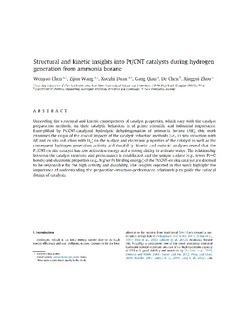| dc.contributor.author | Chen, Wenyao | |
| dc.contributor.author | Wang, Zijun | |
| dc.contributor.author | Duan, Xuezhi | |
| dc.contributor.author | Qian, Gang | |
| dc.contributor.author | Chen, De | |
| dc.contributor.author | Zhou, Xinggui | |
| dc.date.accessioned | 2019-03-18T09:26:17Z | |
| dc.date.available | 2019-03-18T09:26:17Z | |
| dc.date.created | 2018-12-15T16:16:50Z | |
| dc.date.issued | 2018 | |
| dc.identifier.citation | Chemical Engineering Science. 2018, 192 1242-1251. | nb_NO |
| dc.identifier.issn | 0009-2509 | |
| dc.identifier.uri | http://hdl.handle.net/11250/2590414 | |
| dc.description.abstract | Unraveling the structural and kinetic consequences of catalyst properties, which vary with the catalyst preparation methods, on their catalytic behaviors is of prime scientific and industrial importance. Exemplified by Pt/CNT-catalyzed hydrolytic dehydrogenation of ammonia borane (AB), this work examines the origin of the crucial impacts of the catalyst reduction methods (i.e., in situ reduction with AB and ex situ reduction with H2) on the surface and electronic properties of the catalyst as well as the consequent hydrogen generation activity and durability. Kinetic and isotopic analyses reveal that the Pt/CNT-ex situ catalyst has low activation energy and a strong ability to activate water. The relationship between the catalyst structure and performance is established, and the unique surface (e.g., fewer PtO bonds) and electronic properties (e.g., higher Pt binding energy) of the Pt/CNT-ex situ catalyst are deemed to be responsible for the high activity and durability. The insights reported in this work highlight the importance of understanding the preparation-structure-performance relationship to guide the rational design of catalysts. | nb_NO |
| dc.language.iso | eng | nb_NO |
| dc.publisher | Elsevier | nb_NO |
| dc.rights | Attribution-NonCommercial-NoDerivatives 4.0 Internasjonal | * |
| dc.rights.uri | http://creativecommons.org/licenses/by-nc-nd/4.0/deed.no | * |
| dc.title | Structural and kinetic insights into Pt/CNT catalysts during hydrogen generation from ammonia borane | nb_NO |
| dc.type | Journal article | nb_NO |
| dc.type | Peer reviewed | nb_NO |
| dc.description.version | acceptedVersion | nb_NO |
| dc.source.pagenumber | 1242-1251 | nb_NO |
| dc.source.volume | 192 | nb_NO |
| dc.source.journal | Chemical Engineering Science | nb_NO |
| dc.identifier.doi | 10.1016/j.ces.2017.05.056 | |
| dc.identifier.cristin | 1643675 | |
| dc.description.localcode | © 2017. This is the authors’ accepted and refereed manuscript to the article. Locked until 1 June 2019 due to copyright restrictions. This manuscript version is made available under the CC-BY-NC-ND 4.0 license http://creativecommons.org/licenses/by-nc-nd/4.0/ | nb_NO |
| cristin.unitcode | 194,66,30,0 | |
| cristin.unitname | Institutt for kjemisk prosessteknologi | |
| cristin.ispublished | true | |
| cristin.fulltext | original | |
| cristin.qualitycode | 2 | |

